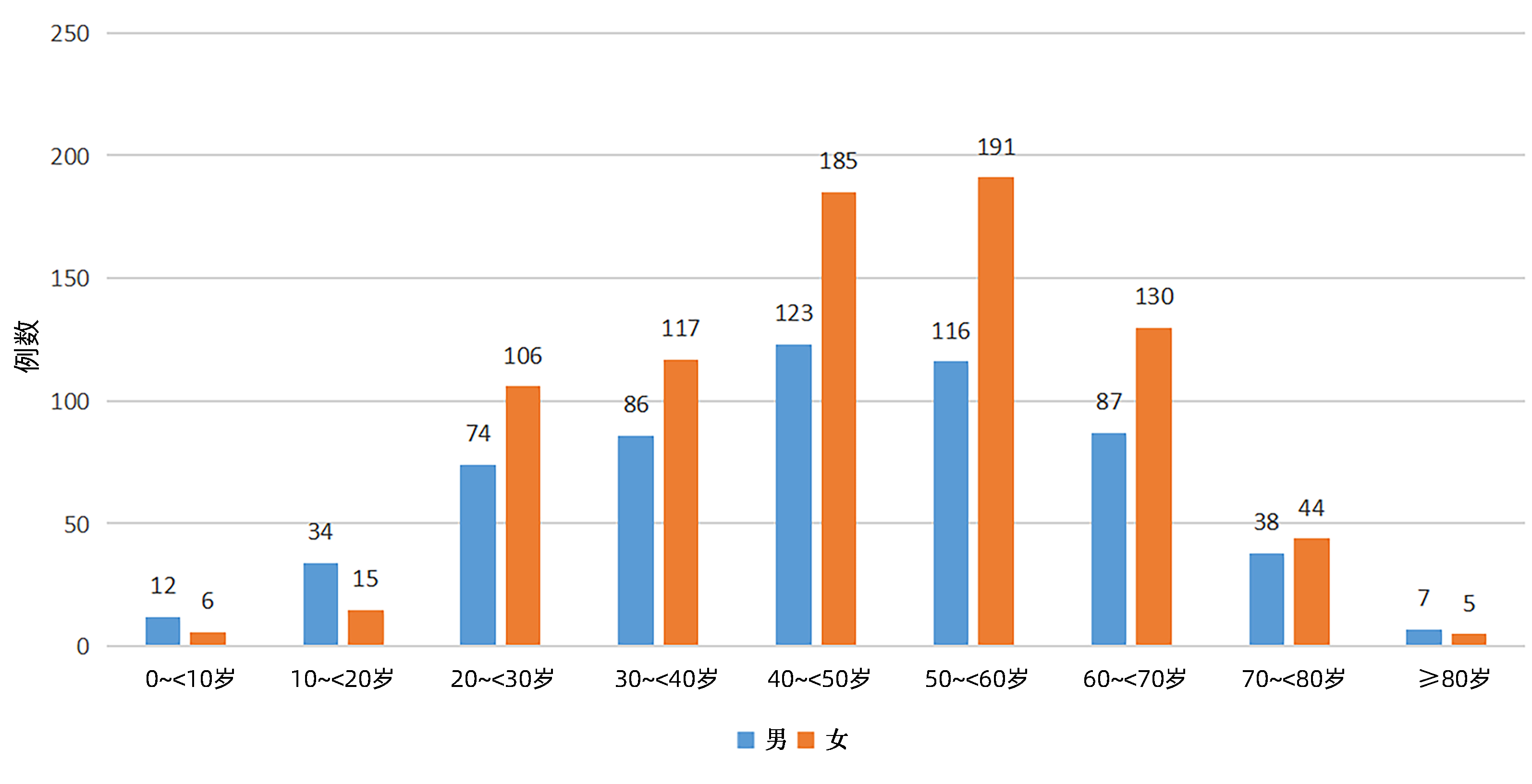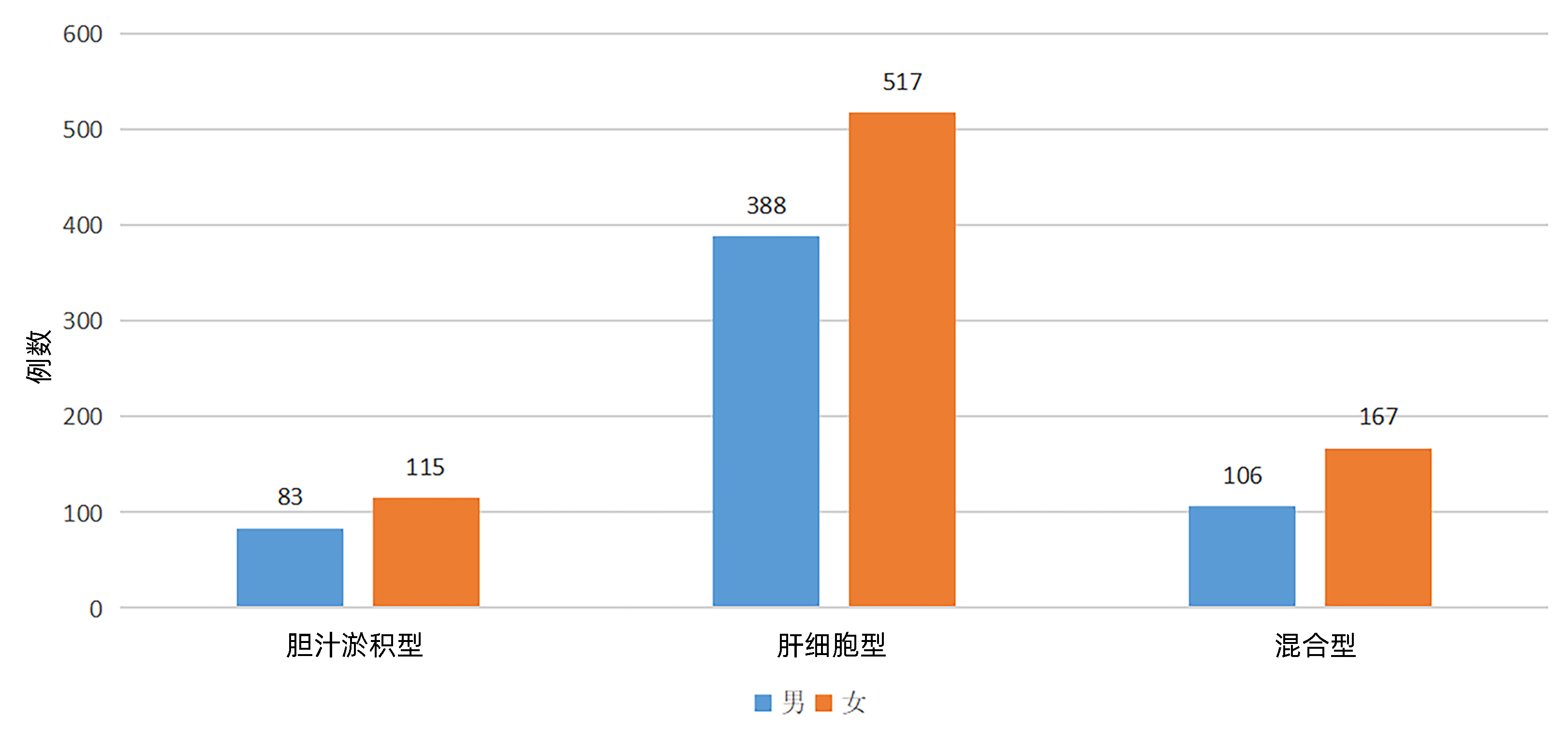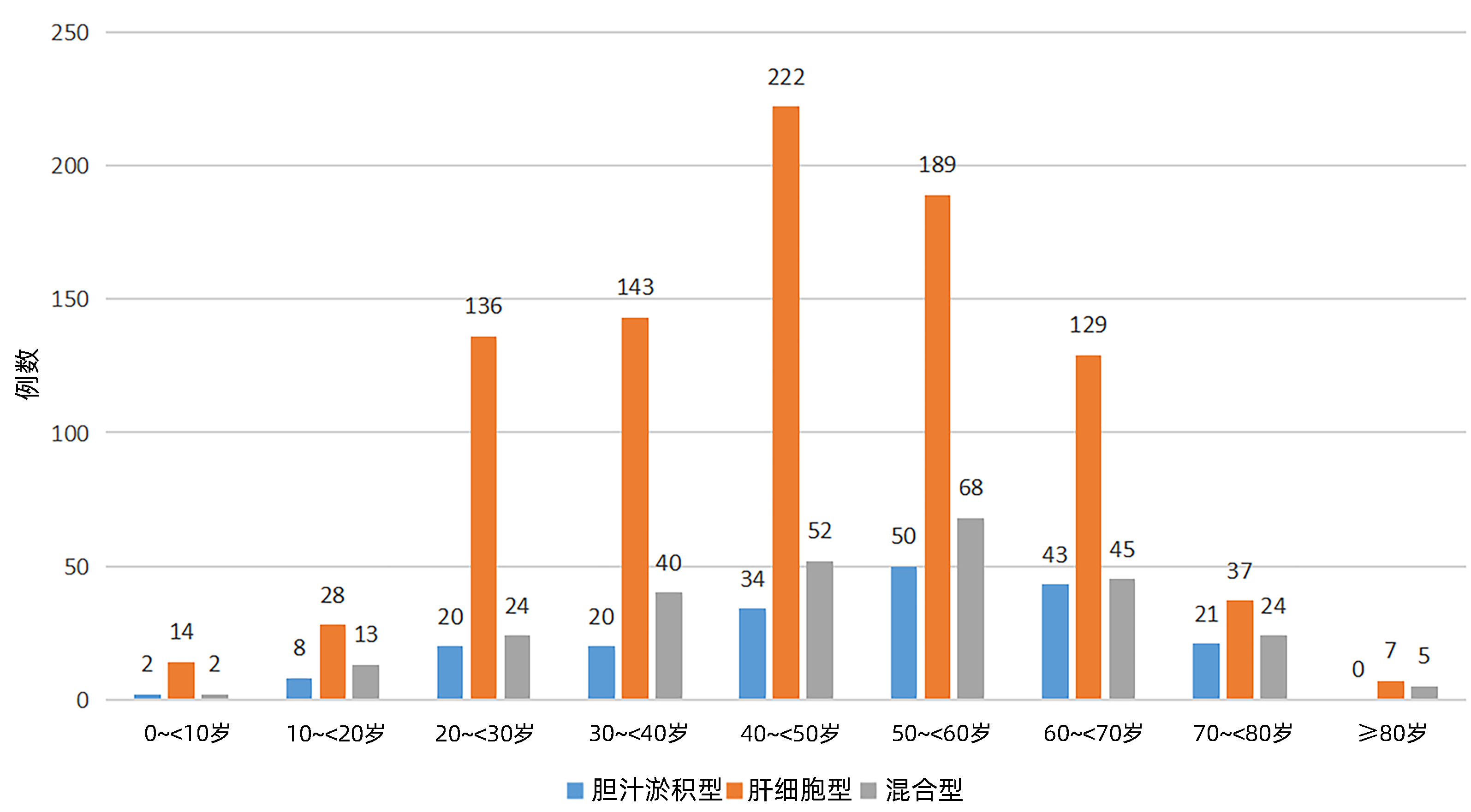陕西省2009—2019年药物性肝损伤患者的临床特征分析
DOI: 10.3969/j.issn.1001-5256.2023.06.016
Clinical features of patients with drug-induced liver injury in Shaanxi Province from 2009 to 2019
-
摘要:
目的 探讨药物性肝损伤(DILI)患者的临床特点。 方法 回顾性收集陕西省内20家医院2009—2019年收治的以RUCAM量表为诊断标准的1 376例药物性肝损伤患者的临床资料,分析性别、年龄、基础疾病、可疑肝损伤药物、临床表现、实验室检查、治疗经过及预后。计量资料2组间比较采用成组t检验或Wilcoxon秩和检验;计数资料组间比较采用χ2检验;多分类有序资料比较采用Kruskal-Wallis H秩和检验。 结果 1 376例患者中男577例(41.93%),女799例(58.07%),男女比为0.72∶1;各年龄段中40~60岁年龄段高发,占比44.77%;各年龄组中男女性别分布差异有统计学意义(χ2=20.784,P=0.008),三种临床分型中,男女发病占比差异无统计学意义(χ2=1.409,P=0.494),各年龄组中临床分型分布差异有统计学意义(χ2=47.025,P<0.001)。引起肝损伤的药物中,居前三位的依次为:中药(41.13%)、抗结核药(11.70%)、解热镇痛药(7.27%)。临床分型以肝细胞损伤型为主,占比65.77%(905例);住院时间平均15.31天,以1~4周居多,占比91.86 %;痊愈45例(3.27%),好转1 322例(96.08%),整体预后较好。不同临床分型的预后不同,差异具有统计学意义(H=59.300,P=0.011),进一步比较显示,肝细胞损伤型和混合型预后好于胆汁淤积型(P<0.05),肝细胞损伤性和混合型预后差异无统计学意义(P>0.05)。 结论 DILI在女性及中老年的占比较高,中药是引起DILI的首位原因,不同临床分型的预后不同,整体预后较好。 -
关键词:
- 化学性与药物性肝损伤 /
- 症状和体征 /
- 预后
Abstract:Objective To investigate the clinical features of patients with drug-induced liver injury (DILI). Methods A retrospective analysis was performed for the clinical data of 1 376 patients with DILI who were admitted to 20 hospitals in Shaanxi Province, China, from 2009 to 2019 and were diagnosed with RUCAM scale as the diagnostic criteria, and these patients were analyzed in terms of sex, age, underlying diseases, suspected drugs causing DILI, clinical manifestations, laboratory examination, treatment process, and prognosis. The t-test and Wilcoxon test were used for comparison of continuous data between two groups, the chi-square test was used for comparison of categorical data between groups, and the Kruskal-Wallis H rank sum test was used for comparison of ordered polytomous data between groups. Results Among the 1 376 patients, there were 577(41.93%) male patients and 799 (58.07%) female patients, with a male/female ratio of 0.72:1. As for different age groups, the 40-60 years group had a higher incidence rate and accounted for 44.77%, and there was a significant difference in sex distribution between different age groups (χ2=20.784, P=0.008). As for the three clinical types, there was no significant difference in incidence rate between men and women (χ2=1.409, P=0.494), and there was a significant difference in the distribution of clinical types between different age groups (χ2=47.025, P < 0.001). The top three drugs causing DILI were traditional Chinese medicine (41.13%), antitubercular agents (11.70%), and antipyretic and analgesic drugs (7.27%). Hepatocellular injury type was the main clinical type and accounted for 65.77% (905 cases). The mean length of hospital stay was 15.31 days, mostly 1-4 weeks which accounted for 91.86%. Among these 1376 patients, 45 (3.27%) were cured and 1 322 (96.08%) were improved, suggesting a good overall prognosis. The patients with different clinical types had significantly different prognoses (H=59.300, P=0.011), and further comparison showed that the patients with hepatocellular injury type and mixed type had a significantly better prognosis than those with cholestasis type (P < 0.05), while there was no significant difference in prognosis between the patients with hepatocellular injury type and those with mixed type (P > 0.05). Conclusion There is a high incidence rate of DILI in women and middle-aged and elderly people, and traditional Chinese medicine is the leading cause of DILI. Patients with different clinical types tend to have different prognoses, with a good overall prognosis. -
Key words:
- Chemical and Drug Induced Liver Injury /
- Symptoms and Signs /
- Prognosis
-
表 1 1 376例DILI患者的服药种类及构成比
Table 1. Medication types and composition ratio of 1 376 patients with drug-induced liver injury
药物种类 例数 占比(%) 主要药物 中药 566 41.13 何首乌、乌头碱、土三七、菟丝子、黄芪、地黄、山茱萸、茯苓、白术、白芷、青黛、大黄、蒲公英、五味子、地肤子 抗结核药 161 11.70 异烟肼、利福平 解热镇痛药 100 7.27 扑热息痛、尼美舒利、复方氨酚烷胺片、对乙酰氨基酚、布洛芬止疼片 抗微生物药 95 6.90 阿莫西林、阿奇霉素、甲硝唑、酮康唑 保健品 79 5.74 减肥药、防脱发药 心脑血管用药 76 5.52 他汀类药物 抗肿瘤药 65 4.72 甲氨蝶呤、表柔比兴、多西他赛、紫杉醇 激素 35 2.54 溴隐停 甲状腺用药 35 2.54 甲巯咪唑、丙硫氧嘧啶、他巴唑 精神类用药 30 2.18 丙戊酸钠、卡马西平、劳拉西泮、氯氮平 皮肤病用药 27 1.96 去白巴布司片、消银丸、白癜风胶囊 胃肠道用药 27 1.96 奥美拉唑、兰索拉唑 降糖药 16 1.16 二甲双呱、阿卡波糖、格列齐特 免疫抑制剂 13 0.94 环孢素a 化学毒物 7 0.51 染发剂、油漆 抗过敏药 7 0.51 扑尔敏、依巴斯汀、盐酸左西替利嗪片 藏药 l 0.07 不详 蒙药 l 0.07 不详 用药不明确 35 2.54 不详 表 2 DILI患者不同临床分型的住院时间
Table 2. Hospitalization time of DILI patients with different clinical types
临床分型 例数 <2周 2~<4周 4~<6周 6~<8周 8~<10周 ≥10周 肝细胞型[例(%)] 905 444(44.06) 388(42.87) 59(6.52) 6(0.66) 5(0.55) 3(0.33) 胆汁淤积型[例(%)] 198 103(52.02) 78(39.39) 16(8.08) 0(0.00) 1(0.51) 0(0.00) 混合型[例(%)] 273 150(54.95) 101(37.00) 15(5.49) 6(2.20) 0(0.00) 1(0.37) 总计[例(%)] 1 376 697(50.65) 567(41.21) 90(6.54) 12(0.87) 6(0.44) 4(0.29) 表 3 DILI患者不同临床分型的预后
Table 3. Prognosis of DILI patients with different clinical types
临床分型 例数 治愈 好转 无效 死亡 肝细胞型[例(%)] 905 39(4.31) 859(94.92) 5(0.55) 2(0.22) 胆汁淤积型[例(%)] 198 2(1.01) 194(97.98) 2(1.01) 0(0.00) 混合型[例(%)] 273 4(1.47) 269(98.53) 0(0.00) 0(0.00) 总计[例(%)] 1 376 45(3.27) 1322(96.08) 1(0.51) 2(0.15) 表 4 DILI患者不同预后的一般情况比较
Table 4. General comparison of different outcomes in DILI patients
指标 痊愈(n=45) 未痊愈(n=1 331) 统计值 P值 年龄 43.67±16.38 46.27±16.17 t=1.060 0.289 性别[例(%) χ2=0.330 0.566 女 28(62.2) 771(57.9) 男 17(37.8) 560(42.1) 基础疾病[例(%)] χ2=0.083 0.773 有 11(24.4) 301(22.6) 无 34(75.6) 1030(77.4) 生化指标 ALT(U/L) 669(338~1 008) 359(142~770) Z=0.006 0.938 AST(U/L) 366(204~683) 242(94~558) Z=0.668 0.414 ALP(U/L) 123(68~203) 144(96~202) Z=0.175 0.676 GGT(U/L) 128(60~264) 135(70~248) Z=0.585 0.444 TBil(μmol/L) 58(23~86) 69(19~184) Z=6.593 0.010 临床分型[例(%)] χ2=9.098 0.011 胆汁淤积型 2(4.4) 196(14.7) 肝细胞型 39(86.7) 866(65.1) 混合型 4(8.9) 269(20.2) 致病药物[例(%)] χ2=6.377 0.041 中药 23(51.1) 680(51.1) 西药 16(35.6) 511(38.4) 中西药 6(13.3) 140(10.5) 保肝药数量[例(%)] χ2=0.417 0.812 1种 4(8.9) 247(18.6) 2种 8(17.8) 358(26.9) 3种 33(73.3) 726(54.5) 住院天数(d) 17.29±9.12 15.22±9.31 t=1.465 0.143 -
[1] Drug-induced Liver Disease Study Group, Chinese Society of Hepatology, Chinese Medical Association. Guidelines for the management of drug-induced liver injury[J]. J Clin Hepatol, 2015, 31(11): 1752-1769. DOI: 10.3969/j.issn.1001-5256.2015.11.002.中华医学会肝病学分会药物性肝病学组. 药物性肝损伤诊治指南[J]. 临床肝胆病杂志, 2015, 31(11): 1752-1769. DOI: 10.3969/j.issn.1001-5256.2015.11.002. [2] HAYASHI PH, BJORNSSON ES. Long-term outcomes after drug-induced liver injury[J]. Curr Hepatol Rep, 2018, 17(3): 292-299. DOI: 10.1007/s11901-018-0411-0. [3] LO REV 3rd, HAYNES K, FORDE KA, et al. Risk of acute liver failure in patients with drug-induced liver injury: evaluation of Hy's law and a new prognostic model[J]. Clin Gastroenterol Hepatol, 2015, 13(13): 2360-2368. DOI: 10.1016/j.cgh.2015.06.020. [4] YU YC, MAO YM, CHEN CW, et al. CSH guidelines for the diagnosis and treatment of drug-induced liver injury[J]. Hepatol Int, 2017, 11(3): 221-241. DOI: 10.1007/s12072-017-9793-2. [5] DANAN G, BENICHOU C. Causality assessment of adverse reactions to drugs—I. A novel method based on the conclusions of international consensus meetings: application to drug-induced liver injuries[J]. J Clin Epidemiol, 1993, 46(11): 1323-1330. DOI: 10.1016/0895-4356(93)90101-6. [6] HAYASHI PH, FONTANA RJ. Clinical features, diagnosis, and natural history of drug-induced liver injury[J]. Semin Liver Dis, 2014, 34(2): 134-144. DOI: 10.1055/s-0034-1375955. [7] CHALASANI NP, MADDUR H, RUSSO MW, et al. ACG clinical guideline: Diagnosis and management of idiosyncratic drug-induced liver injury[J]. Am J Gastroenterol, 2021, 116(5): 878-898. DOI: 10.1055/s-0034-1375955. [8] WANG J, SONG YY, LI Y. Case analysis of 104 cases of drug-induced liver injury[J]. Chin J Drug Appl Monit, 2020, 17(1): 37-40, 66. DOI: 10.3969/j.issn.1672-8157.2020.01.010.王洁, 宋艳艳, 李颖. 104例药物性肝损伤的病例分析[J]. 中国药物应用与监测, 2020, 17(1): 37-40, 66. DOI: 10.3969/j.issn.1672-8157.2020.01.010. [9] HE WC, ZHANG KG, ZHAO FH. Clinical characteristics of 290 patients with drug-related liver injury[J]. J Prac Hepatol, 2020, 23(4): 540-543. DOI: 10.3969/j.issn.1672-5069.2020.04.022.何文昌, 张克恭, 赵凡惠. 290例药物性肝损伤患者临床特征分析[J]. 实用肝脏病杂志, 2020, 23(4): 540-543. DOI: 10.3969/j.issn.1672-5069.2020.04.022. [10] BJÖRNSSON ES. Epidemiology and risk factors for idiosyncratic drug-induced liver injury[J]. Semin Liver Dis, 2014, 34(2): 115-122. DOI: 10.1055/s-0029-1240002. [11] RATHI C, PIPALIYA N, PATEL R, et al. Drug induced liver injury at a tertiary hospital in india: etiology, clinical features and predictors of mortality[J]. Ann Hepatol, 2017, 16(3): 442-450. DOI: 10.5604/16652681.1235488. [12] FONTANA RJ, WATKINS PB, BONKOVSKY HL, et al. DILIN Study Group. Drug-Induced Liver Injury Network (DILIN) prospective study: rationale, design and conduct[J]. Drug Saf, 2009, 32(1): 55-68. DOI: 10.2165/00002018-200932010-00005. [13] BJÖRNSSON ES, BERGMANN OM, BJÖRNSSON HK, et al. Incidence, presentation, and outcomes in patients with drug-induced liver injury in the general population of Iceland[J]. Gastroenterology, 2013, 144(7): 1419-1425.e1-3; quiz e19-20. DOI: 10.1053/j.gastro.2013.02.006. [14] LI YF, HAN SJ, GUO YZ. Clinical characteristics analysis of 103 cases of drug-related liver injury[J]. Chin Hepatol, 2019, 24(4): 386-389. DOI: 10.3969/j.issn.1008-1704.2019.04.015.李亚飞, 韩少静, 郭永泽. 103例药物性肝损伤的临床特征分析[J]. 肝脏, 2019, 24(4): 386-389. DOI: 10.3969/j.issn.1008-1704.2019.04.015. [15] XU QL, HE LL, LI C. Clinical study of 516 cases of drug-induced liver injury[J]. Baiqiuen Med J, 2019, 17(3): 223-225. DOI: 10.16485/j.issn.2095-7858.2019.03.006.徐庆玲, 何兰兰, 李纯. 516例药物性肝损伤的临床研究[J]. 白求恩医学杂志, 2019, 17(3): 223-225. DOI: 10.16485/j.issn.2095-7858.2019.03.006. [16] ZHANG XY, CHEN HQ, BAI C. Clinical characteristics of drug-related liver injury and its prognostic assessment[J]. Contemp Med, 2019, 25(7): 137-139. DOI: 10.3969/j.issn.1009-4393.2019.07.055.张旭艳, 陈慧群, 白成. 药物性肝损伤的临床特点及其预后评估[J]. 当代医学, 2019, 25(7): 137-139. DOI: 10.3969/j.issn.1009-4393.2019.07.055. [17] ZHANG X. Clinical comparison analysis of drug-induced liver injury by Chinese and Western drugs[J]. China J Phar Economics, 2016, 11(10): 65-67. DOI: 10.12010/j.issn.1673-5846.2016.10.026.张项. 中药与西药所致药物性肝损伤的临床对比分析[J]. 中国药物经济学, 2016, 11(10): 65-67. DOI: 10.12010/j.issn.1673-5846.2016.10.026. [18] LI XY, TANG JT. Epidemiology of drug-related liver injury[J]. J Clin Hepatol, 2021, 37(11): 2510-2514. DOI: 10.3969/j.issn.1001.5256.2021.11.002.李晓芸, 唐洁婷. 药物性肝损伤的流行病学[J]. 临床肝胆病杂志, 2021, 37(11): 2510-2514. DOI: 10.3969/j.issn.1001-5256.2021.11.002. [19] WANG JH, GUO HD, KONG JJ. Clinical characteristics of patients with drug-induced liver injury caused by anti-tuberculosis drugs and analysis of their risk factors[J]. J Prac Hepatol, 2020, 23(1): 58-61. DOI: 10.3969/j.issn.1672-5069.2020.01.017.王建辉, 郭红丹, 孔晶晶. 抗结核药物致药物性肝损伤患者临床特点及其危险因素分析[J]. 实用肝脏病杂志, 2020, 23(1): 58-61. DOI: 10.3969/j.issn.1672-5069.2020.01.017. [20] LEE WM. Acetaminophen (APAP) hepatotoxicity-Isn't it time for APAP to go away?[J]. J Hepatol, 2017, 67(6): 1324-1331. DOI: 10.1016/j.jhep.2017.07.005. [21] LAMMERT C, EINARSSON S, SAHA C, et al. Relationship between daily dose of oral medications and idiosyncratic drug-induced liver injury: search for signals[J]. Hepatology, 2008, 47(6): 2003-2009. DOI: 10.1002/hep.22272. [22] LI Z, SU H, LENG J. Analysis of the status of drug-related liver damage at home and abroad[J]. Mil Med J Southeast China, 2007, 169(6): 476-480. DOI: 10.3969/j.issn.1672-271X.2007.06.046.李治, 苏华, 冷静. 国内外药物性肝损害状况分析[J]. 东南国防医药, 2007, 169(6): 476-480. DOI: 10.3969/j.issn.1672-271X.2007.06.046. [23] HU Q, LIU W, SHAO H. Research progress in pharmacological treatment of drug-related liver injury[J]. Chin J Clin Pharmacol Ther, 2016, 21(2): 231-236. https://www.cnki.com.cn/Article/CJFDTOTAL-YLZL201602026.htm胡琴, 刘维, 邵宏. 药物性肝损伤的药物治疗研究进展[J]. 中国临床药理学与治疗学, 2016, 21(2): 231-236. https://www.cnki.com.cn/Article/CJFDTOTAL-YLZL201602026.htm -



 PDF下载 ( 2639 KB)
PDF下载 ( 2639 KB)


 下载:
下载:




